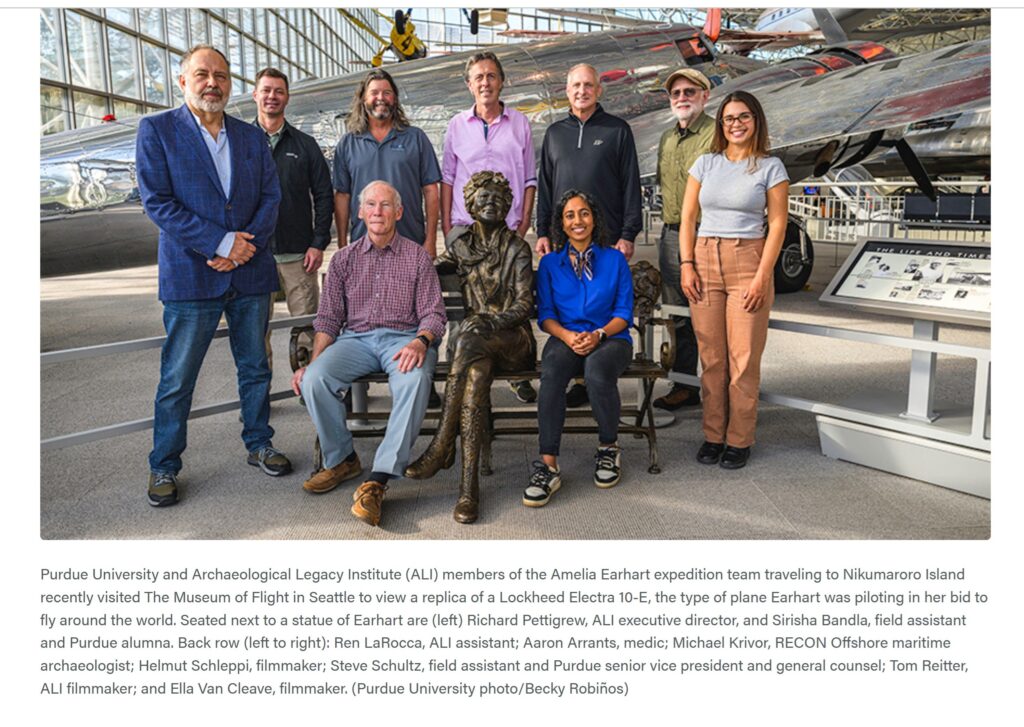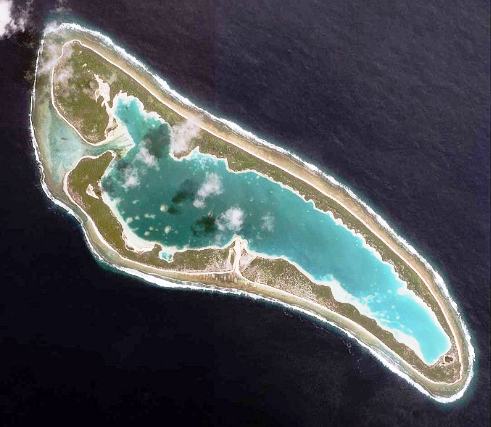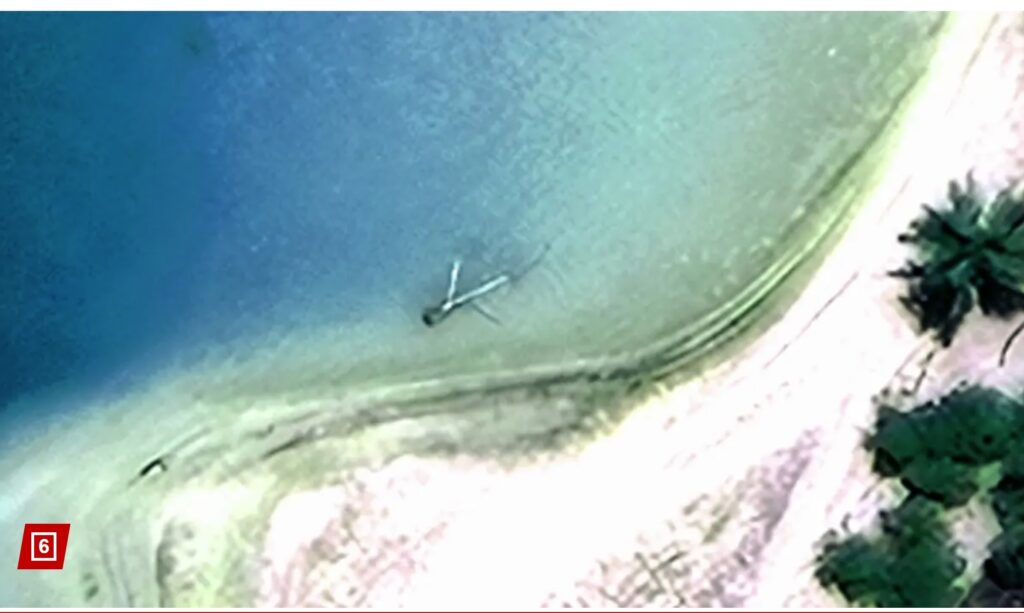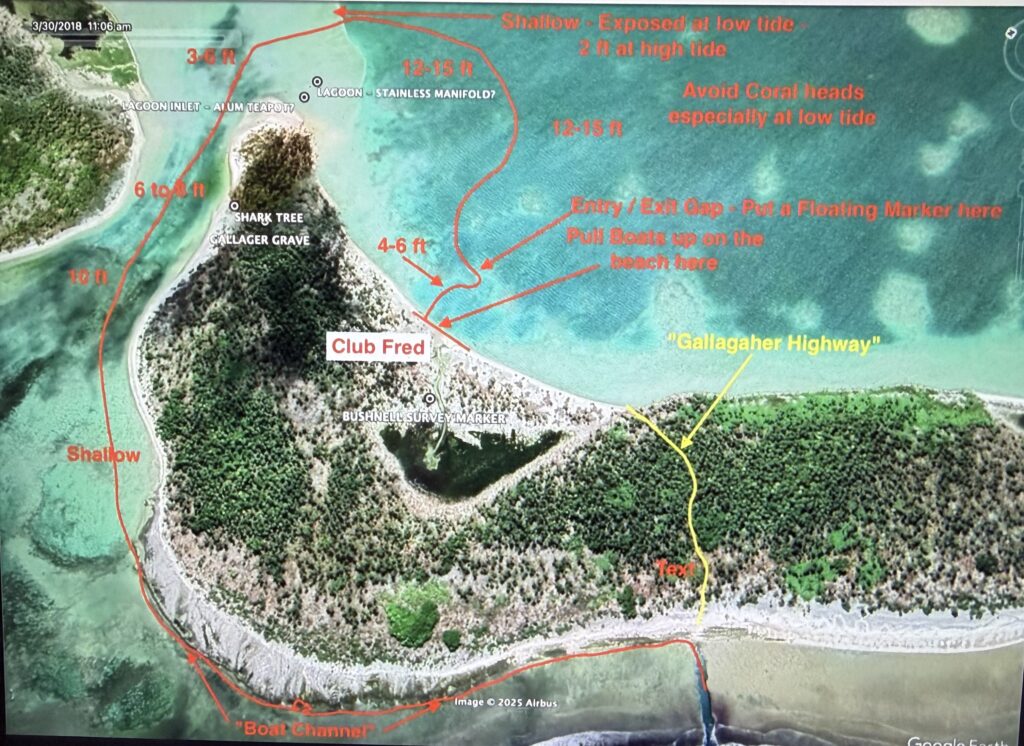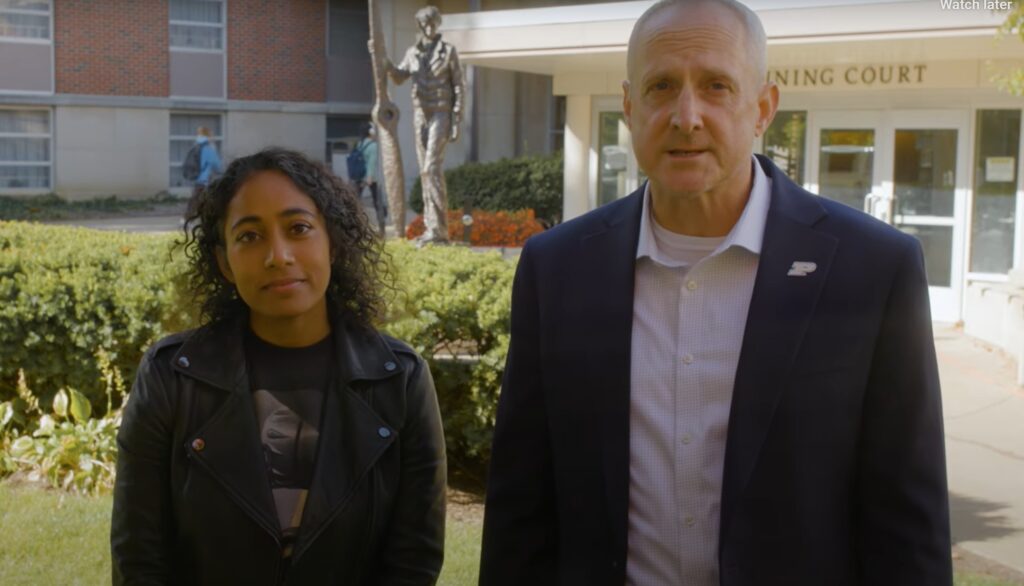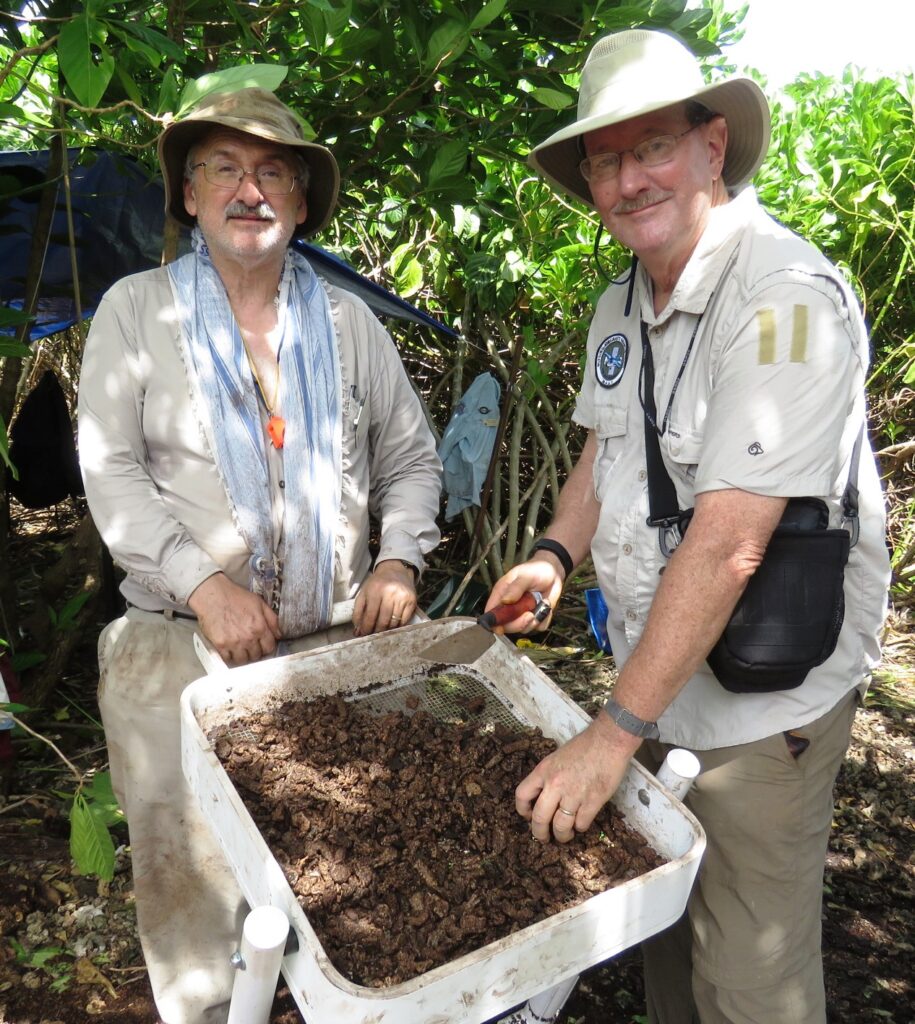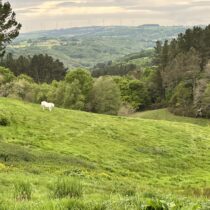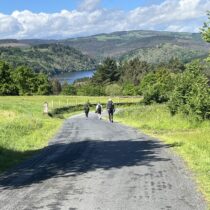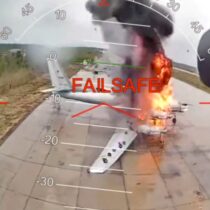
Expedition to Gardner/Nikumaroro Island
If you follow this column you know that one of the several viable hypotheses about the Earhart disappearance is that she and her navigator Fred Noonan landed on remote, uninhabited Nikumaroro Island (ex-Gardner Island) in what is now the Republic of Kiribati in the South Pacific, and survived for a week or two. (Links to my previous Earhart columns are provided below.) This month I was going to continue writing on the Camino de Santiago, but then this happened: a major expedition to Nikumaroro was planned, announced, then postponed at the last minute until 2026. There is a slim but greater than zero chance that Amelia and her plane will be found, next year, on Nikumaroro.
The tentatively planned expedition is led by Rick Pettigrew, PhD, RPA, the head of The Archaeology Channel and the Archaeological Legacy Institute, and was set for November 2025, but will now be undertaken in 2026, likely in the summer. It will set sail from Majuro in the Marshall Islands (ironically the setting for another Earhart theory, that she was murdered in the Marshalls by forces of the Empire of Japan), will spend five days on the island, and will announce any findings to the public after returning to the US.
The expedition will sail on two 80-foot ocean-going vessels, will have about 14 members, and will focus on identifying the now famous “Taraia Object” in the north part of the island’s lagoon, off Taraia Point. This object can be seen on a number of satellite and other images over the years. Rick and his sponsors (mainly the Purdue Research Foundation of Purdue University, which has a strong Earhart connection) theorize that the Object is the fuselage and one or two broken-off wings of Earhart’s Lockheed Electra 10-E.
Criticisms of the Taraia Object Hypothesis
Critics of this theory argue the following:
- The Object is more likely a concretion of coconut or buka (the “bird-catching tree”, Pisonia grandis) logs and other debris, washed in from shallow entrance to the lagoon. This explains why the Object does not appear in all the photos, because the logs rot or are washed elsewhere by frequent storms.
- This area just off Taraia Point was surveyed by sailors from the USS Bushnell just three years after the disappearance, and they did not report seeing aircraft debris, and no such wreck appears on the detailed charts with soundings that they produced. A similar New Zealand 1938/9 survey did not notice the plane.
- This area was also examined by previous TIGHAR expeditions to the island, including a survey done via manta boards towed underwater with expedition members on them.
- The sediment off the Point is not deep enough to conceal even a crushed fuselage.
Having said that, it is certainly true that the Object exists, and there is some possibility that the Electra fuselage was crushed, intermittently covered with sand and sticky muck (which I am quite familiar with, having waded through it on another part of the island), and that it is close enough to the beach that the TIGHAR manta board and Bushnell and NZ surveyors missed it.
Expedition Challenges
The expedition was set to sail this month, in November 2025, which is not the ideal time, due to possible storms and perhaps a full tropical cyclone. The effort is dangerous, and faces a number of challenges, including:
- Getting into the lagoon is very tricky. The expedition vessels must reach the island a few hours before high tide, which happens only once a day during daylight. They must quickly launch their hard-bottomed Zodiacs and one jet-ski, get through the very shallow lagoon entrance at high tide or just before without getting stuck, then run them up on the beach at “Club Fred” – a beach on the interior. The next morning they must take staff and gear into the cut in the coral reef opposite Club Fred, unload without breaking limbs or getting cut on the razor sharp, slippery coral (easy to do), then re-open the trail through the jungle across the island to Club Fred, reload the gear and staff onto the Zodiacs, and head over to Taraia Point.
- Avoiding the 20-inch-wide coconut crabs, with claws that can crack open a coconut, or a skull.
- Treating any injuries on site. While the expedition has evacuation insurance, uninhabited Nikumaroro is one of the most isolated places on the planet, and any major evacuation would probably take at least three days, and perhaps involve sailing to American Samoa (643 nautical miles away), for plane transfer to Oahu (1800 NM from Niku). Majuro, at 1100 NM away, is too far. Luckily the effort has a terrific paramedic on board who is experienced in expedition medicine.
- The two vessels are small enough that seasickness from the persistent Pacific swells is quite likely. Since there is no anchorage on or off Niku, and the island offers little shelter from the swells, and the explorers must return to their vessels each night, seventeen straight days of seasickness are quite possible. Not fun!
Another challenge is funding. The expedition has the backing of the Purdue Research Foundation, but this is apparently partial backing and may be contingent on success. Risky.
And yet another challenge is getting the required permit to undertake activities on the island. As of late October the Republic of Kiribati had not yet issued a permit, and the effort was postponed to 2026 to work this problem. There will be a Kiribati official aboard who has the power to stop the effort and to ensure that only authorized activities are undertaken. The Chinese government has a lot of influence in Kiribati, and may not want this US-based expedition to take place. Yikes!
The Earhart disappearance has received renewed attention since President Trump announced the release of all related government documents. However, all the experts I know on the matter contend that there are no such secret Earhart files in existence.
I wish Rick and his valiant effort all the luck in the world, and hope that they solve this 88-year-old puzzle – perhaps the greatest missing aircraft mystery in history.
Links:
Purdue YouTube on backing the expedition:
https://www.youtube.com/watch?v=O3PfucJ9na4
Purdue YouTube on postponing the expedition:
Interview with Rick Pettigrew:
https://www.youtube.com/watch?v=DUEEnxhpzsg
Previous Toulmin Travel Tales columns on Earhart and the search, 2025:
https://www.mymcmedia.org/new-developments-in-the-search-for-amelia-earhart-part-1/
https://www.mymcmedia.org/new-developments-in-the-search-for-amelia-earhart-part-2/
Previous relevant Toulmin Travel Tales columns, 2021:
https://www.mymcmedia.org/blog-latest-developments-in-the-search-for-amelia-earhart-part-1/
A. Amelia Earhart and navigator Fred Noonan disappeared on July 2, 1937, somewhere in the north or south Pacific. The mystery generated headlines all around the world.
B. A team from Purdue University’s Research Foundation assembled at the Seattle Museum of Flight in September 2025 to help launch the effort to examine Taraia Point in the Gardner/Nikumaroro lagoon, in hopes of finding the Earhart Electra. Note the statue of Amelia.
C. A satellite photo of Nikumaroro. Taraia Point is in the north part of the lagoon, pointing downward, opposite and due east of the lagoon entrance on the upper left.
D. The Taraia Object as presented by Rick Pettigrew, PhD and a Registered Professional Archaelogist, of the Archaeological Legacy Institute.
E. Getting into the Niku lagoon is quite difficult. Zodiacs must enter the dangerous sharp-coral channel at the bottom of the photo, go west, then north, across the shallow entrance channel at high tide, and loop around to Club Fred. The next morning the team enters the channel, beaches, re-cuts the “Gallagher Highway” through the jungle to the lagoon, gets in the Zodiacs, then heads to Taraia Point to begin the real work.
F. The 2017 TIGHAR expedition team to Niku heads back to their large ship, waiting in the swells off the island. The slippery, sharp coral channel is calm here but is quite dangerous in heavy seas.
G. Commercial astronaut Sirisha Bandla and Purdue VP Steve Schultz announce the delay of the Niku expedition from November 2025 to 2026, due to permitting issues. Both will participate in the forthcoming expedition. Purdue holds the Earhart archives, and is the university which Amelia wanted to house her Lockheed Electra after she completed her round-the-world trip. Purdue hopes to bring home the Electra’s remains.
H. Amelia Earhart and Fred Noonan in 1937, with a map of their historic but fatal round the world expedition.
I. Author Lew Toulmin of Silver Spring and Arthur Rypinski of Rockville on Nikumaroro in 2017, searching through thousands of bits of coral that look like human bones, searching for the bones of Amelia Earhart.


